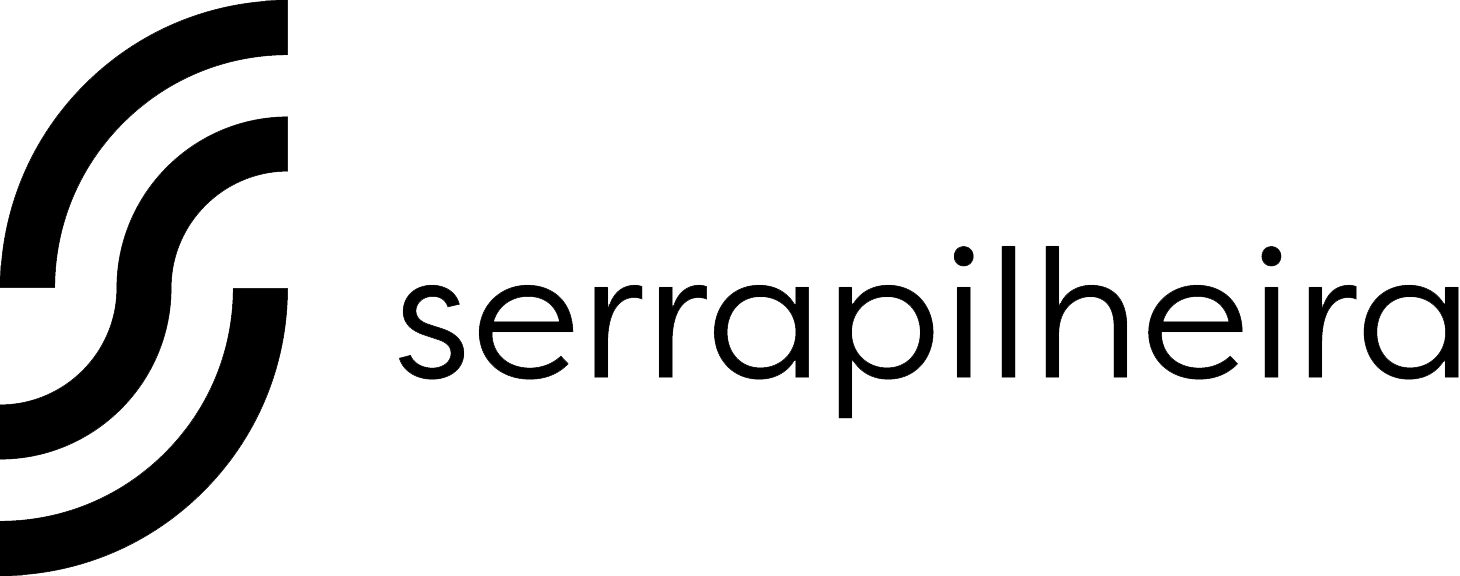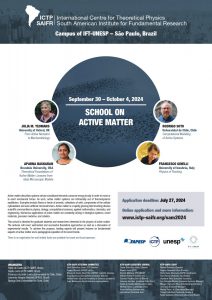School on Active Matter


September 30 – October 4, 2024
São Paulo, Brazil
ICTP-SAIFR/IFT-UNESP
Zoom ID: 826 3818 4873
Password: matter
Home
Active matter describes systems whose constituent elements consume energy locally in order to move or to exert mechanical forces. As such, active matter systems are intrinsically out of thermodynamic equilibrium. Examples include flocks or herds of animals, collections of cells, components of the cellular cytoskeleton and even artificial microswimmers. Active matter is a rapidly growing field involving diverse scientific communities in physics, biology, computational sciences, applied mathematics, chemistry, and engineering. Numerous applications of active matter are constantly arising in biological systems, smart materials, precision medicine, and robotics.
This school is intended for graduate students and researchers interested in the physics of active matter. The lectures will cover well-tested and successful theoretical approaches as well as a discussion of experimental results. To achieve this purpose, leading experts will present lectures on fundamental aspects of active matter and a pedagogical exposition of its recent trends.
Applicants are invited to submit abstracts for poster presentations.
There is no registration fee and limited funds are available for travel and local expenses.
Organizers:
- Pablo de Castro (ICTP-SAIFR, Brazil)
- Danilo Liarte (ICTP-SAIFR, Brazil)
- Francisca Guzmán-Lastra (Universidad de Chile, Chile)
- Leonardo Gregory Brunnet (UFRGS, Brazil)
- Rodrigo Soto (Universidad de Chile, Chile)
List of Participants: Updated on Otctober 04, 2024.
Survey: Here
Lectures
Lecturers:
- Julia M Yeomans (University of Oxford, UK): From Active Nematics to Mechanobiology
- Rodrigo Soto (Universidad de Chile, Chile): Computational Modeling of Active Systems
- Aparna Baskaran (Brandeis University, USA): Theoretical Foundations of Active Matter: Lessons from Ideal Microscopic Models
- Francesco Ginelli (University of Insubria, Italy): Physics of Flocking
For computational exercises, desk computers will be available during the exercise sessions in a computer lab on the ground floor at the IFT-UNESP building. If you wish to use your own laptop, we recommend installing Anaconda/Python.
Special Presentation:
- Antonio Romaguera (Universidade Federal Rural de Pernambuco, Brazil): Active matter with Hexbugs robot toys: Experimental demonstration
Registration
Program
Poster Sessions
Poster Session 1 (Monday, September 30):
- Ahmed Elhady (Max Planck Institute of Animal Behavior / University of Konstanz): Mechanistic theory of social foraging
- Ana Novaes Dias (UFMG): Mean Field Theory for a Vicseklike Model on a Lattice
- Andrea Soledad Gotting (Physics Department, Institute of Sciences, National University of General Sarmiento, Argentina): Study of bacterial aggregation of Pseudomona Extremaustralis 2E-UNGS for bioremediation processes.
- Antonio Romaguera (Universidade Federal Rural de Pernambuco / Departamento de Física): Multifractal fluctuations in zebrafish (Danio rerio) polarization time series
- Bernardo Boatini (Institudo de Fisica da UFRGS): Wetting of Active Droplets
- Constanza Rivas (Universidad de Concepción): Modeling early biofilm formation through multigenerational surface-sensing transmission on active particles
- Davi Lazzari (Instituto de Física – UFRGS): Tuning collective actuation of active solids by optimizing activity localization
- Emanuel Fortes Teixeira (Instituto de Física da Universidade Federal do Rio grande do Sul (UFRGS)): Segregation in binary mixture with differential contraction among active rings
Poster Session 2 (Tuesday, October 1):
- Fernando Francisco Silva Filho (IF USP): Stochastic Thermodynamics and collective effects on 4-state molecular motors
- Fidel Álvarez (Pontificia Universidad Católica de Chile): Growth Dynamics in a Mechanical Model of Cellular Colonies
- FRANCISCO CAROL BONFIM LEAL (Universidade Federal Rural do Pernambuco): Avalanche dynamics of zebrafish schools: unveiling self-organization and phase transitions
- Guillermo Fadic(Universidad de Chile): Phase diagram of bioconvection patterns formed by magnetotactic bacteria
- Ignacio Bordeu (Universidad de Chile): Modelling branching morphogenesis
- Ignacio Peña Orellana (Pontificia Universidad Catolica de Valparaiso) and Javiera Navarro Pérez (Pontificia Universidad Catolica de Valparaiso): Characterization of MG1655 E.Coli bacterial chemotaxis navigation in a complex media
- Italo Ignacio Salas (Universidad de Chile): Emerging double power-law through dynamical complex networks in motility-induced phase separation in Active Brownian Particles
- Joaquin Morales (Universidad de Chile): Collective fractional Brownian motion driven by spatiotemporal light gradients
Poster Session 3 (Wednesday, October 2):
- Jorge Mario Escobar Agudelo (UNESP-IFT): Correlated Disorder and Viscoelasticity of Soft Colloidal Gels
- Kelly Aparecida Molica (Universidade Federal de Viçosa): Cell self-organization in culture: from chance to motility cell-induced gradients
- Leonardo Leiva (Pontificia Universidad Católica): Yielding Transition in Active Systems
- Luiz Menon Junior (Pontifícia Universidade Católica do Rio de Janeiro): Random search in heterogeneous media
- Marcos Pasa (Instituto de Física – UFRGS): Stokes Flow With Active Rings
- Marina Palacio Fornero (Instituto de Física Enrique Gaviola – Facultad de Matematica, Astronomia, Física y Computación – Universidad Nacional de Córdoba): Human sperm dynamics under confinement
- Matheus Gomes (UFRPE): Exploring Dynamics of BEAM Robots in Complex Potentials Using 3D Printed Models
- Mayron González (Universidad de Chile): Complexity emerges in measures of the marking dynamics in football games
- Yhony Mamani Arce (UNESP-IFT): Anomalous dynamic scaling of an active particle embedded in a smectic liquid crystal
Poster Session 4 (Thursday, October 3):
- Michael Torres Ramirez (Universidade Federal do Ceará): Plateau-Rayleigh-like instability in interacting binary mixtures of active particles
- Nathan de Oliveira Silvano (Universidade do Estado do Rio de Janeiro): Emergent Gauge Symmetry in Active Brownian Particles
- Nycholas Guedes Rufini (Universidade de São Paulo): Dynamics of the Vallis model for El Niño phenomenon with periodic perturbation
- Opiyo Alphonce Ndolo (Pontificia Universidad Católica de Valparaiso, Chile): Quantitative analysis of Bacterial navigation and diffusion under hemodynamic conditions for bacteriotherapy application
- Oscar Sebastian Garrido (Universidad de Chile): Collective Organization of Magnetotactic bacteria in a Droplet under External Magnetic Field
- Pablo Pérez (Universidad de Chile): Coupled dynamics of density and polarization fields of active Brownian particles.
- Paulo Casagrande Godolphim (Departamento de Fisica – Universidad de Chile): Mechanical Heterogeneity in Fish Embryos
- Rafael Dias Vilela (UFABC): Dynamics and sorting of run-and-tumble particles in fluid flows with transport barriers
Poster Session 5 (Friday, October 4):
- Peter Marinko (University of Ljubljana, Ljubljana, Slovenia): Helically confined liquid crystal simulation
- Renne Rodrigues Rosinelli Junior (Institute of Physics/ Univerty of Sao Paulo): Computational simulation of microscopic models for dilute biaxial nematic liquid crystals
- RUAN VICTOR ALMEIDA QUIRINO (universidade federal rural de pernambuco): Calculation of the Lyapunov exponent of the dynamics of robots in non-integrable domains
- Sebastián de la Maza Rodríguez (Universidad de Chile): Aggregation processes in layered environments
- Vinícius Bayne Müller (UFRGS): Phase transitions of epidemic spreading in complex networks
- Alphonce Opiyo (Pontificia Universidad Católica de Valparaíso): Quantitative analysis of Bacterial navigation and diffusion under hemodynamic conditions for bacteriotherapy application
- Yago Pontual (Universidade Federal Rural de Pernambuco): Topological arrangement of self-propelled particles in confined potentials
All abstracts: HERE
Videos and Files
Slides: Professor Francesco Ginelli
2024-09-30-
09:00 - Julia M Yeomans (University of Oxford, UK):
From Active Nematics to Mechanobiology - Class 1
- 11:00 - Rodrigo Soto (Universidad de Chile, Chile): Computational Modeling of Active Systems - Class 1
- 14:00 - Aparna Baskaran (Brandeis University, USA): Theoretical Foundations of Active Matter: Lessons from Ideal Microscopic Models - Class 1
-
16:00 - Francesco Ginelli (University of Insubria, Italy):
Physics of Flocking - Class 1
-
09:00 - Julia M Yeomans (University of Oxford, UK):
From Active Nematics to Mechanobiology - Class 2
- 11:00 - Rodrigo Soto (Universidad de Chile, Chile): Computational Modeling of Active Systems - Class 2
- 14:00 - Aparna Baskaran (Brandeis University, USA): Theoretical Foundations of Active Matter: Lessons from Ideal Microscopic Models - Class 2
-
09:00 - Francesco Ginelli (University of Insubria, Italy):
Physics of Flocking - Class 2
-
11:00 - Julia M Yeomans (University of Oxford, UK):
From Active Nematics to Mechanobiology - Class 3
- 14:00 - Julia M Yeomans (University of Oxford): Active nematics: A new approach to mechanobiology?
-
15:30 - Antonio Romaguera (Universidade Federal Rural de Pernambuco, Brazil):
Active matter with Hexbugs robot toys: Experimental demonstration
- 16:00 - Rodrigo Soto (Universidad de Chile, Chile): Computational Modeling of Active Systems - Class 3
-
09:00 - Julia M Yeomans (University of Oxford, UK):
From Active Nematics to Mechanobiology - Class 4
-
10:00 - Aparna Baskaran (Brandeis University, USA):
Theoretical Foundations of Active Matter: Lessons from Ideal Microscopic Models - Class 3
-
14:00 - Francesco Ginelli (University of Insubria, Italy):
Physics of Flocking - Class 3
-
09:00 - Rodrigo Soto (Universidad de Chile, Chile):
Computational Modeling of Active Systems - Class 4
-
10:00 - Aparna Baskaran (Brandeis University, USA):
Theoretical Foundations of Active Matter: Lessons from Ideal Microscopic Models - Class 4
-
14:00 - Francesco Ginelli (University of Insubria, Italy):
Physics of Flocking - Class 4
asdasdasd
Photos
Additional Information
Attention! Some participants in ICTP-SAIFR activities have received email from fake travel agencies asking for credit card information. All communication with participants will be made by ICTP-SAIFR staff using an e-mail “@ictp-saifr.org”. We will not send any mailings about accommodation that require a credit card number or any sort of deposit.
BOARDING PASS: All participants, whose travel has been provided or will be reimbursed by ICTP-SAIFR, should bring the boarding pass upon registration. The return boarding pass (PDF, if online check-in, scan or picture, if physical) should be sent to secretary@ictp-saifr.org by e-mail.
COVID-19: Brazilians and foreigners no longer have to present proof of vaccination before entering the country.
Visa information: Nationals from several countries in Latin America and Europe are exempt from tourist visa. Nationals from Australia, Canada and USA are exempt from tourist visa until April 10, 2025. Please check here which nationals need a tourist visa to enter Brazil.
Accommodation: Participants, whose accommodation will be provided by the institute, will stay at The Universe Flat. Hotel recommendations are available here.
How to reach the Institute: The first week of the school will be held at ICTP South American Institute, located at IFT-UNESP, which is across the street from a major bus and subway terminal (Terminal Barra Funda). The address which is closer to the entrance of the IFT-UNESP building is R. Jornalista Aloysio Biondi, 120 – Barra Funda, São Paulo. The easiest way to reach us is by subway or bus, please find instructions here.
Poster presentation: Participants who are presenting a poster MUST BRING A PRINTED BANNER . The banner size should be at most 1 m (width) x 1,5 m (length). We do not accept A4 or A3 paper.

